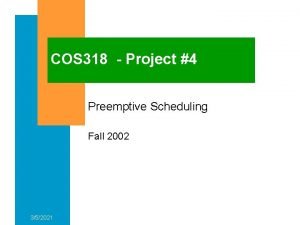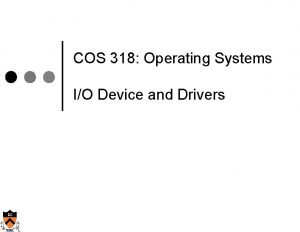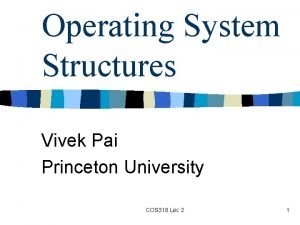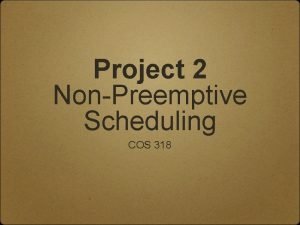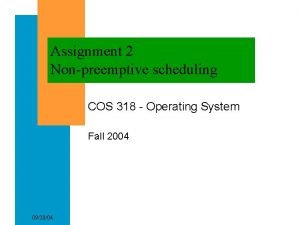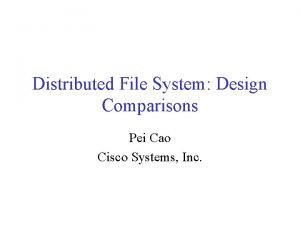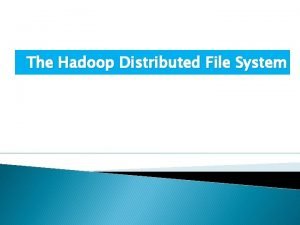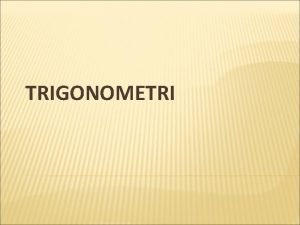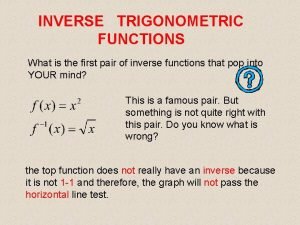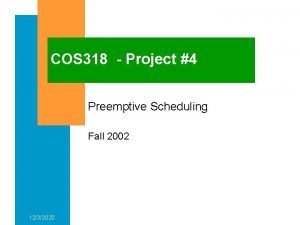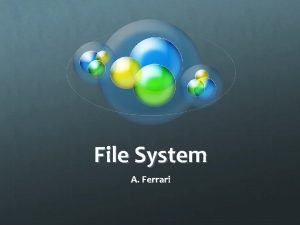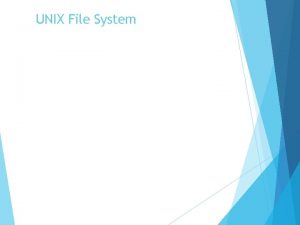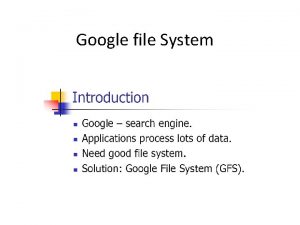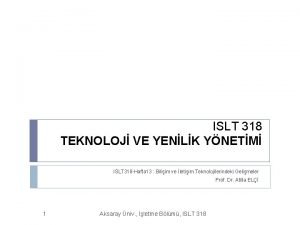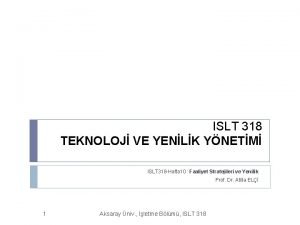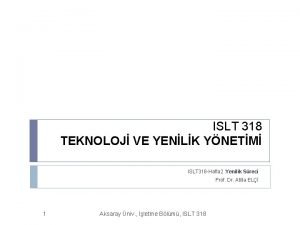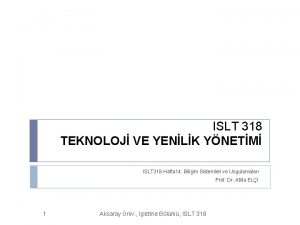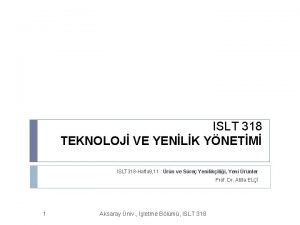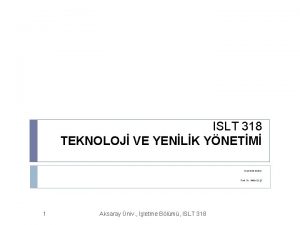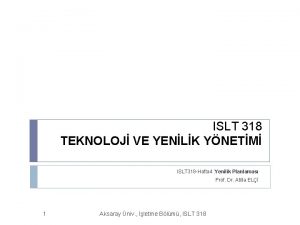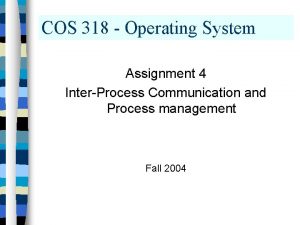Project 3 File System Design COS 318 Fall























- Slides: 23

Project 3: File System Design COS 318 Fall 2002

Last Time • Web Server u/ vivek/ public_html/ server client request response index. html cos 318_02/ • Extensive use of a file system on server machine without actually worrying about how it was implemented.

Outline • • • Introduction Design requirement Helper functions Implementation of file system calls Hints Reference

Introduction • Why do we need a file system? – Abstraction – Protected access – Security • Simple Unix-like file system – i-node – directory tree – links(symbolic/physical)

What does my file server need to accomplish • A New Client Program with • New Methods: – GET <dir name | file name> • Fetch a file or dir listing and show them – CREATE <dir name> • Create a dir in server disk – DELETE <file name | dir name> • Delete a file or dir in server disk • populated directories should not be deleted – PUT <file name> <local file name> <startpos> <endpos> • Create a new file in server disk, or append to an exsiting file with contents from local file [Notice: name uses absolute path]

More on file server functionality • Use our client program to create a populated directory tree inside of server disk, and then use your web server to serve this content. • More test programs: – Randomly requests – Maybe not just be PUT or GET: after some file deletions, things will become more interesting. – Coming soon…

So what do you have • A Virtual Disk: a data structure – Disk_name: dev_318 – Disk_pointer: used to access the disk(in fact a file descriptor) – Sector_size: 512 bytes – Capacity: M, G … • Rather than write to a real disk, you'll be building a disk inside of a large file • All development and debugging are in user space

Helper Functions: not tuxedo • • • Get. Existing. Disk(char *pathname) Create. New. Disk(void) Close. Disk(void) Read. Sector(int sector. Num, char *buf) Write. Sector(int sector. Num, char *buf) Notice: – You are allowed to access disk only with those function calls;

Helper Functions(cont. ) • Get. Existing. Disk(char *pathname) – returns a pointer to previously created disk in directory pathname, or exits if no such disk • Create. New. Disk(void) – returns a pointer to a new disk • Close. Disk(void) – closes the virtual disk(dev_318)

Helper Functions(cont. ) • Read. Sector(int sector. Num, char *buf) – reads 512 bytes from disk • Write. Sector(int sector. Num, char *buf) – writes 512 bytes from disk • Notice: – If any other user space function calls can facilitate your work, feel free to use them. • Using file system functions to build disk is relatively easy compared to using really disk to build file system

What do I need to do • You should build on the code you wrote for the previous assignments – Good thing: we have a reference server • The first step is to understand the default file system provided by the base code(helper functions) • You'll have to understand at least one new header with one of the new methods.

What do I need to do(cont. ) • You'll have to write versions of various system calls that you used in Project 1 – mkfs, open, close, read, and write – Additionally, you'll also have to implement versions of stat, mkdir, and a few others, also function calls to getting file metadata and directory information in order to properly build directory listings • No need to handle all of the various flags and parameters, but should implement enough to get the project working correctly

One example-open() • For example, the open() system call can be used to try to test the existence of a file in addition to creating it for writing • O_CREATE: the file creation flag – To properly handle “PUT" method • Not always true: need other flags – “GET” a non-existent file

mkfs • File system creation – Dos: format – Linux: mkfs/mke 2 fs/mkfs. msdos – Solaris: newfs • Structure of a typical file system(unixlike) – Superblock • Describes layout of i-Nodes, bitmaps, blocks, root directory, etc. – i-Nodes • Describes a file/dir – Link counter, list of blocks, size, etc. (owner, permission, …) – Block Allocation Bitmap – Data blocks

mkfs(cont. ) • Creates the file system – – Set up the Superblock Flag all i-Nodes as type free (f) Zero out the Alloc Bitmap Create the root directory • • Flag an i-Node as type directory (D) Store it’s number in Superblock Alloc one block in the bitmap Initialize the ‘. ’ and ‘. . ’ directory entries and set the others as being INVALID Block Bootblock Super Alloc Kernel Block i-Nodes Bitmap* Procs Data Blocks

Super. Block • Describes the layout of the file system – – – – – signature – A magic number size – Total size of fs in blocks root_inode – The root directory inode_start – 1 st block for i-Nodes inode_blocks – Total i-Nodes blocks bitmap_start – 1 st block of bitmap_blocks – Total bitmap blocks alloc_start – 1 st block for data num_blocks – Total data blocks free_blocks – Count of unallocated blocks

Bitmap • Bitmap – Indicates which data blocks are free, and which are used – Maps the data blocks only (not i-Nodes)

I-node • Describes a file/directory – – – type – File, directory opens – Count of open file handles links – Count of links to this i-Node size – Total byte count direct[10] – List of data blocks indirect[3] – List of indirect blocks • Advantages – Fast access to small files – Supports very large files – Support sparse files

Hints • Break this project into two components expansion of the main server itself, and implementation of the underlying disk • Within the file system: – Start with the creation of files and try to get that working properly; – Then build directories on top of that mechanism; – Finally work on directory listing support. • For files: direct blocks first

More Hints • Keep the high level interface as much as possible – By having wrappers that can either call the real call or your replacement, you'll be able to do testing quickly and efficiently • Standard interface: – Stat(const char *pathname, struct stat *buf)

stat • Returns statistics for given a filename – – – inode. No – The file’s i-Node number Type – File or directory Opens – The open count Size – The byte count to EOF num. Blocks – Number of allocated blocks

Reference • Check the manual page of the function calls – What they do – What’s their interface – What’s the most useful parameters

Wrap Up • • Fun again? Probably…. Not too difficult. But a little bit more coding. Questions?
 File-file yang dibuat oleh user pada jenis file di linux
File-file yang dibuat oleh user pada jenis file di linux Cos 318
Cos 318 Cos318
Cos318 Cos 318 princeton
Cos 318 princeton Operating system design issues
Operating system design issues Cos318
Cos318 Cos 318°=
Cos 318°= Cos 318
Cos 318 Cos 318°
Cos 318° Distributed file system
Distributed file system In a file-oriented information system, a transaction file
In a file-oriented information system, a transaction file Distributed file system examples
Distributed file system examples Hadoop distributed file system architecture design
Hadoop distributed file system architecture design What are the design issues of distributed operating systems
What are the design issues of distributed operating systems Difference between logical file and physical file
Difference between logical file and physical file Fungsi sistem file
Fungsi sistem file Markup tag tells the web browser
Markup tag tells the web browser Nilai dari sin150o adalah
Nilai dari sin150o adalah Cos c -cos d
Cos c -cos d Sin½
Sin½ Sen(a+b)+sen(a-b)
Sen(a+b)+sen(a-b) Fabula
Fabula Testo narrativo scopo
Testo narrativo scopo What quadrants is arccos restricted to
What quadrants is arccos restricted to

